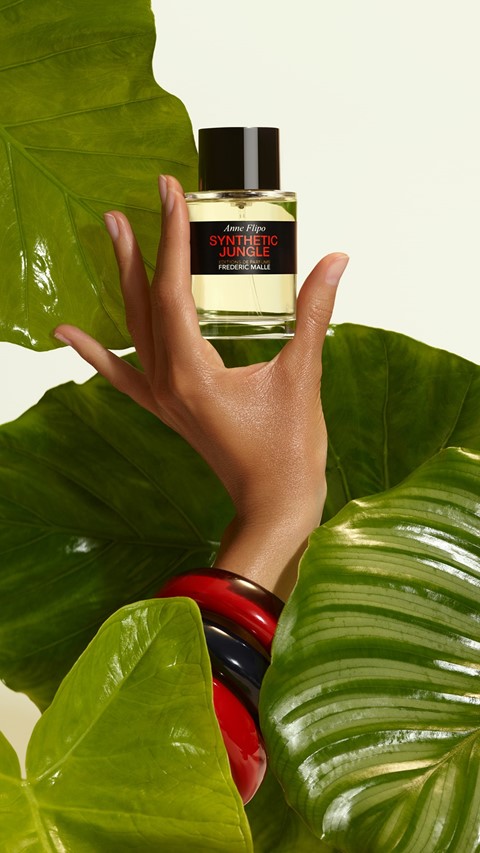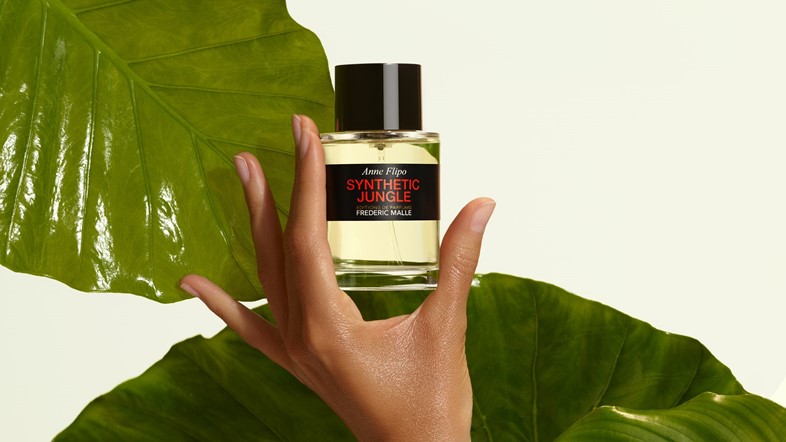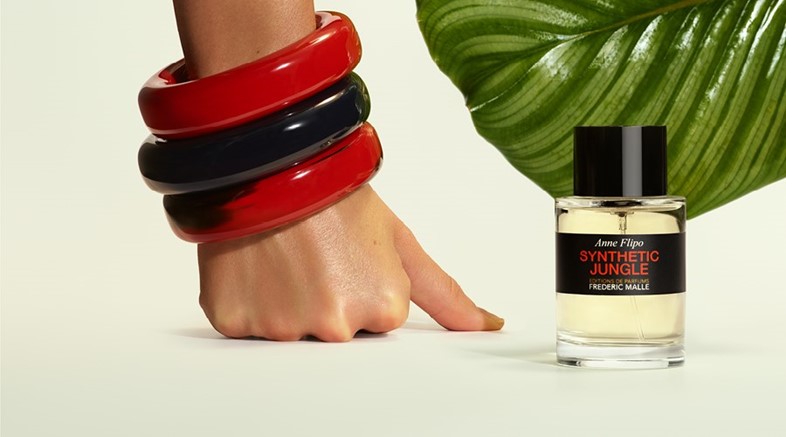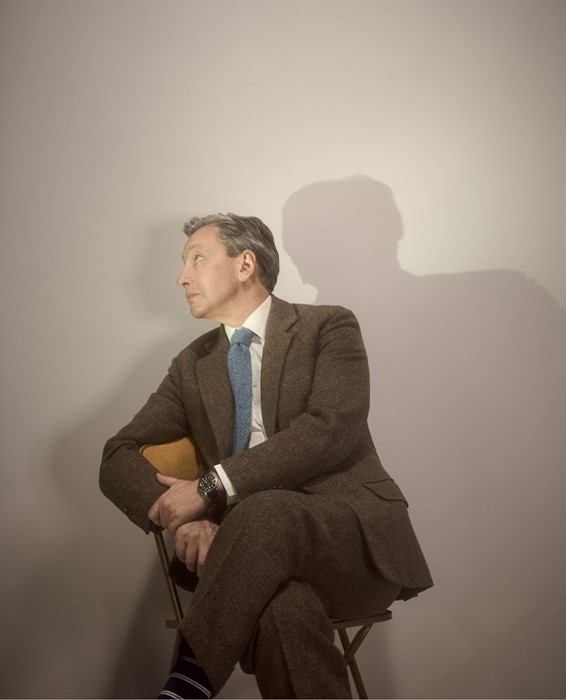Frédéric Malle changed the perfume industry forever with his eponymous fragrance portfolio, which puts perfumers front and centre. Synthetic Jungle, Anne Flipo’s recent creation for him, is as revolutionary and sardonic as the maison itself
Born into the business, Frédéric Malle is a bit of a heretic in the perfume industry – as a brief but mighty biography can attest. Bucking family tradition (Malle’s grandfather Serge Heftler-Louiche founded Parfums Christian Dior, his mother later became the company’s art director) Frédéric moved to Manhattan to study history of art at NYU, before accepting a position at the renowned perfume laboratory Roure Bertrand Dupont. Roure merged with Givaudan – now the largest fragrance and flavour company in the world – in 1991 but at its height was the invisible force behind wildly successful perfumes for houses like Estée Lauder, Elizabeth Arden, Coty, and Revlon. Here, Malle worked for 25 years with the industry’s best-kept secrets – its under-celebrated, yet entirely essential noses – inspiring Malle to launch Editions de Parfums Frédéric Malle in 2000.
It was a radical moment for olfactive aficionados: a series of nine distinct perfumes, each created by a master perfumer and labelled with little besides its name and that of its creator, in minimal red and white type on a stark black label. Malle offered his perfumers unparalleled creative freedom and unlimited access to the high-quality ingredients of their choosing – a curator of sorts, it was his editorial overview that connected them. In an arc of almost poetic symmetry, EPFM was bought by Estée Lauder in 2014 and with 32 fragrances now under its roof, it has since transformed the way we talk about perfume and its creators. The rebellious subsidiary of a global behemoth, Malle is rebelling from within the machine.
A passionate collector of contemporary art, Malle is an aesthete in the truest sense – a connoisseur sensitive to art and beauty – but he’s also a straight-talker, both playful and perverse in his attitude to creation. When we connect on a video call over the summer, he is sniffing a series of paper blotters while I set up my recording device, they are alterations to formula he’s been working on which, as a toxicology report had recently revealed, contained a residual chemical that was banned in Korea. As we talk he recalls a candle that because of different regulations could not be sold in Australia. “Excuse my English,” Malle says. “But I said ‘Fuck that, they’re not going to have it, I’m just not going to sell it there. Australia is going to hate me for the rest of my life.’” Lauder gives him the great freedom to do whatever he wants, of which the brand’s latest release Synthetic Jungle is a perfect example. A vibrant green juice brimming with leafy basil and the off-kilter metallic green tang of styrallyl acetate, its freshness is imperceptibly undercut by white flowers – “that horse shit type of smell” – via hyacinth and lily of the valley accords, Egyptian jasmine oil and ylang ylang, a synthetic blackcurrant brings a touch of kitsch, while resinous galbanum and smoky patchouli oil earth the scent, rooting it to the skin. All at once “stylized, hyper-real and fantastical”, as the accompanying mini brochure reads, it is also a wry middle-finger to traditional conceptions of perfumery. Malle is by all accounts an iconoclast.

Sophie Bew: Can talk me through your process? How do you go about commissioning a Frédéric Malle perfume? And how did Synthetic Jungle come to fruition?
Frédéric Malle: Well, I am very good friends with most of these perfumers. People like Dominique Ropion, Carlos Benaim, Maurice Roucel – even during the pandemic we were calling each other for no reason whatsoever, just talking shop. It’s a geek thing – you have to be obsessed to do this job. But when making a fragrance together we go back and forth, it’s like jamming, like working on a song. In our language, we discuss scents, a little bit like a decorator imagining how a red room would look when painted pink – in that way, we can visualise the smell. So ideas come either from the perfumer, or from me, or finding new inspiration together. Then the perfumer writes a quick sketch of a formula, it looks like an Excel spreadsheet – it’s a list of ingredients, dosages. It’s like a loose drawing. Still, it gives you a good idea of whether the idea is valid or not. If we think it’s good, we keep on shaping it. Then, once we’re more or less in agreement about where we are going, then the torture begins. Because the first part, the more experimental one, it’s the fun part. After that, there are entire months of tweaking while you try not to lose the idea – otherwise, you lose everything.
Anyway, Anne Flipo and I always knew we’d work together, and I knew that she was very good with flowers. I had this idea of making a green perfume – green is interesting because it’s in a vegetal world, it’s more or less an abstraction but made with things that have a familiar atmosphere. There were a few perfumes with that sort of vibe, there was one in the 50s called Volver, and then there were a few made in the 70s, like 19 by Chanel and Private Collection by Estée Lauder, which is one of the best. Today, it smells like an old lady and it’s a bit dirty but it was a very good idea. It was very academic work in the beginning – we took a close look at the Private Collection and trimmed every single thing that smelled like an old lady. We kept five or six ingredients from a formula that has 200. At that point, it was very brash, it was not a perfume. Still, it was a structure to work from, it gave a direction.
SB: Do you have any other all-time favourite perfumes that aren’t yours?
FM: Oh there are plenty! I am not a nostalgic person whatsoever but I am more drawn to perfumes that remind me of the past. For instance, when I discovered girls and disco, I was wearing Halston Z14, which is one of my all-time favourites for men. And Original Denim was very good, around the same idea. I love all the Guerlain perfumes, although they are very much inspired by Coty, who invented everything. I think [Nina Ricci’s] L’Air du Temps is a very good perfume. In recent times, I think that Dolce & Gabbana Light Blue is a very important perfume.

SB: That’s a great one!
FM: It’s very good, it’s clever, it’s smart. I think that what Jean-Claude Ellena did with men’s perfumes, whether it’s Declaration or Terre – although I like Declaration better – was remarkable. For smaller houses, I love what Serge Lutens has done – Feminite du Bois, for instance, is a great perfume. There are not that many at the moment. I don’t want to sound like a grandfather but when I started in this business I remember going down the stairs to Les Bains Douche, a nightclub in Paris – it was the first time that I smelled Angel. I remember thinking, “Holy shit, what’s this? This is very interesting.” So I went up to the girl that was wearing it and asked her, which I always did, but now I don’t – I don’t know if it’s because I’m lazy, or because I can’t smell anymore, or because I have become shy but I don’t go to people and ask them what perfume they are wearing. There are not many head-turners anymore.
SB: Really? Can you think of any from the last 10 years?
FM: Yeah, Terre by Hermes must have been one of them. That’s one ... there’s one that I really don’t like aesthetically but that has every ingredient for success. It’s [Maison Francis Kurkdjian’s] Baccarat Rouge 540 perfume. I think it smells like a Kardashian, but it’s a very powerful, easy to recognise well-balanced thing.
SB: What do you think has changed? Why do you think there aren’t as many head-turners these days?
FM: Oh, that’s quite easy – it’s the same reason I started this company, to be very grandiose! In the old days, perfumeries were mom-and-pop businesses and run by people who, from one generation to the other, knew how to sell perfumes and would do it in a very personalised way. So if you were this young, fresh, trying-to-look-innocent girl – although wicked – they would sell you a L’Air du Temps-type structure that smelled like a very very pretty flower but had this very musky base and, in fact, was a little bit more enticing than it seemed at first glance. If they were serving a femme fatale kind of person, they would have to find a tuberose or a Shalimar type. So you would decide what to sell according to who you were dealing with, which allowed brands to make things that were very, very specific. Now the minute these perfumeries were replaced by self-service spaces like Sephora, brands had to adapt to this new distribution and the whole system changed. Suddenly there was no more service, brands had to make perfumes that were one-size-fits-all. Then they had to push it with advertising, create an event and get a celebrity to endorse it, and sell it for cheap – people go for it because they’re buying a piece of the actress but not really for the perfume. So the perfume can’t be too specific. A head-turner is something that is very specific, something that has a lot of power. Now, when it comes to perfumes, power is fairly expensive. [Today] all the money goes to the image, the bottle, and to the top notes so as to make the perfume as dazzling as possible.
SB: Dazzling in the shop …
FM: Yeah, and then it fades away quite quickly. Before you had things that had this strong character from head to toe, from beginning to finish, and so they would diffuse, whereas now if you diffuse too much, you’re a bit segmenting, a bit frightening. One of the reasons I started this company was the thought that we would have our own shop and very strong service, so that we could go back to making very specific perfumes with high-quality ingredients, a very streamlined composition, and they would be very specific, well-signed, diffusing and long-lasting. But you have to give the right one to the right individual. So instead of spending money on the bottle and the ad, I decided not to forgo imagery altogether – although I love imagery. I had one specific bottle for the entire collection and all the money is in the juice. So it was a reaction to the market that made me do what I’m doing. Still, I think that [tuberose-heavy] Carnal Flower or [the Turkish rose-loaded] Portrait of a Lady is a head-turner.

SB: They definitely are. Can you tell me more about Synthetic Jungle – the name is interesting because it’s obviously not your first fragrance to contain synthetic ingredients …
FM: Yeah, it’s funny because we arguably use the most naturals, because we can. Look at Carnal Flower, which has the largest amount of natural tuberose in it; in Portrait Of A Lady there is a shitload of rose, natural rose extract [400 flowers per 100ml bottle, in fact]. Even [the aromatic, woody perfume] French Lover has a lot of naturals in it, although I never say it because I don’t want to comfort people and make them think that natural is best. It’s one of the biggest fake news stories in our industry and it sort of feeds into this new paganism where nature is best and we have to save nature, hence everything that was man-made is to be trashed. So I thought that it was sort of naughty and amusing to call this one Synthetic Jungle. First of all because it has some natural ingredients – the basil, lily of the valley, the floralcy, aspects of grass. They are all little touches of nature that are intertwined to create a completely different landscape.
It’s a bit like the movie Avatar, you have ferns all over the place but there’s nowhere in the world that looks like that place – islands don’t float in the air. Yet every element is made with stuff that we know – so it’s synthetic in the sense that, just like every other perfume, it’s the work of the mind, and although it has natural elements it’s not pure nature. And it’s a jungle because it’s green and lush but it’s a dream jungle because the real jungle is a frightening place, there’s a lot of yellowish, brownish slippery stuff and damp, smelly air. The dream jungle is close to paradise, it’s the Garden of Eden. So it’s an idealisation but it’s also to nag people and highlight the paradox that, in order for you to reproduce nature, you have to use chemistry. Chemistry delivers the exact same molecules that are found in nature and that cannot be extracted from nature – that’s what people don’t understand. When you extract something from a flower, it smells delicious but it smells like a perfume and, actually, an old one.
SB: It’s a political statement in the perfume world – what do you want the legacy of your company to be?
FM: Oh, it’s very simple. One, I wanted to put perfumers forward, and I think that we have managed already. Two, the ultimate sort of fantasma is to invent some destruction. And thirdly to create classics that will outlive me and people will be wearing in 50 years. If, after me, this company could still be a vehicle for young perfumers to give their best, and for people to find perfumes that are a true, perfect echo of who they are and how they want other people to perceive them, I would be perfectly pleased. When you think of a company like Chanel’s, it’s clear that she invented a whole new system. It’s true, the company had the great karma to be owned by the Wertheimers or Hermès by the Dumas, but it’s great to see that there are machines that keep on living, which is totally exciting. It’s like making children – at one point, you don’t want to control them, you want them to grow and have a life of their own. And this is what I’m trying to do with this company so that it keeps on thriving.
Synthetic Jungle by Anne Flipo for Editions de Parfums Frédéric Malle is out now.
